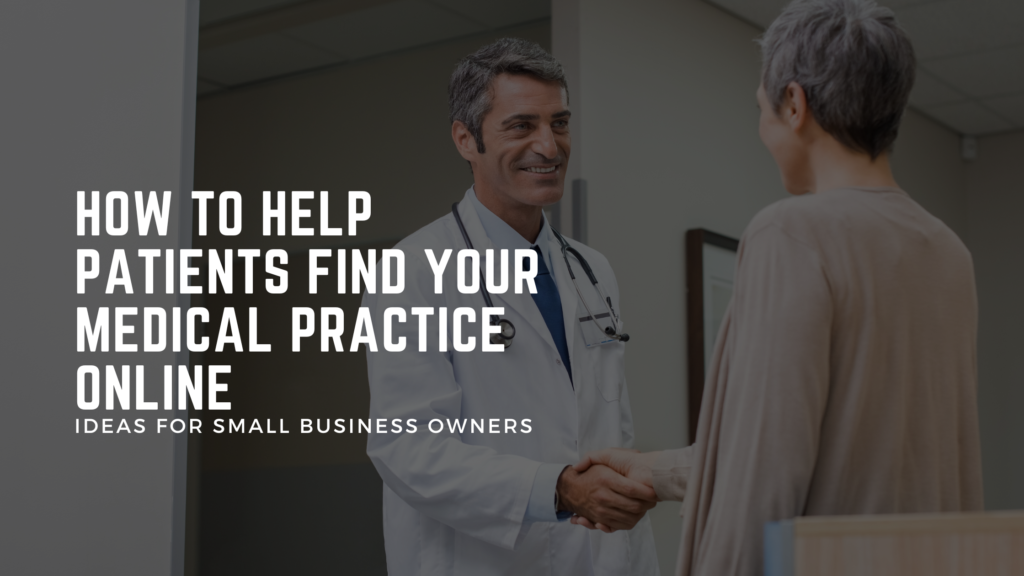In today’s digital age, patients are increasingly turning to the internet to search for medical services. Having a strong online presence is essential for helping patients find your practice, book appointments, and trust you as their healthcare provider. However, many medical practices struggle with how to optimize their online visibility effectively.
In this blog, we’ll explore how to help patients find your medical practice online using proven strategies that improve your search rankings, increase local visibility, and drive more traffic to your website.

1. Optimize Your Google My Business Profile
One of the most powerful tools for helping patients find your medical practice online is Google My Business (GMB). GMB allows your practice to appear in local search results and Google Maps, making it easier for patients in your area to find you.
Here’s how to optimize your Google My Business profile:
- Complete your profile: Ensure that all your business details, including your address, phone number, hours of operation, and website link, are up-to-date.
- Use accurate categories: Choose the most relevant categories for your practice, such as “family doctor,” “dentist,” or “pediatrician.”
- Add photos: Upload professional photos of your practice, staff, and facilities to make your profile more engaging and trustworthy.
- Encourage reviews: Positive reviews are critical for building trust and improving your ranking in local search results. Ask satisfied patients to leave a review and respond promptly to all reviews, both positive and negative.
Pro Tip: Regularly update your GMB profile with any changes, such as holiday hours or new services, to keep your information accurate and relevant.
2. Focus on Local SEO
Local search engine optimization (SEO) is essential for helping patients in your area find your medical practice. When patients search for a healthcare provider, they often use terms like “dentist near me” or “pediatrician in [City].” Optimizing your website for local SEO ensures your practice shows up in these types of searches.
Here’s how to improve your local SEO:
- Use location-based keywords: Include your city or neighborhood in your website’s titles, meta descriptions, and content. For example, “Best family doctor in [City]” or “Affordable dental care in [Neighborhood].”
- Optimize your website for mobile: Many patients will search for a doctor on their mobile devices. Make sure your website is mobile-friendly, loads quickly, and provides easy navigation.
- Create local content: Write blog posts or create landing pages that focus on health topics relevant to your local area. This can help attract local patients who are searching for information.
- Get local backlinks: Partner with local organizations or write guest posts for local publications to earn backlinks to your website. This improves your website’s authority and search ranking.
Pro Tip: Make sure your practice’s name, address, and phone number (NAP) are consistent across all online platforms, including your website, GMB profile, and social media. This helps Google verify your location and improves your local search ranking.
3. Ensure Your Website is Optimized for Search Engines
Your website is often the first place patients will go to learn about your practice and services. Ensuring that your website is optimized for search engines will help it rank higher in search results, driving more traffic and increasing your chances of being found by potential patients.
Here’s how to optimize your website for SEO:
- Use relevant keywords: Include healthcare-related keywords throughout your website’s content. Use terms like “primary care physician,” “dentist,” or “medical services” alongside your location to improve search rankings.
- Optimize page titles and meta descriptions: Each page of your website should have a unique title and meta description that accurately describes the page’s content and includes relevant keywords.
- Create high-quality content: Add a blog to your website where you regularly publish articles on healthcare topics. This can help you rank for a broader range of keywords and attract patients searching for specific health-related information.
- Add alt text to images: Ensure all images on your website have descriptive alt text, which helps search engines understand the content of the images and improves your SEO.
Pro Tip: Use tools like Google Search Console and Google Analytics to track how your website is performing in search results and identify areas for improvement.
4. Use Social Media to Increase Visibility
Social media is a powerful tool for increasing your practice’s online visibility and engaging with current and potential patients. While social media doesn’t directly influence search rankings, it can drive traffic to your website, increase brand awareness, and build trust.
Here’s how to effectively use social media for your medical practice:
- Create a business page: Set up business profiles on Facebook, Instagram, and LinkedIn. Ensure that your profiles include accurate contact information, a link to your website, and a clear description of your services.
- Post regularly: Share health tips, patient success stories, and updates about your practice. Use images, videos, and infographics to make your posts more engaging.
- Engage with followers: Respond to comments and messages promptly. Engaging with your followers helps build trust and encourages more people to interact with your content.
- Promote special offers or events: If your practice offers seasonal services (such as flu shots) or holds health-related events, promote these on social media to attract more patients.
Pro Tip: Use Facebook Ads to target specific demographics in your area. You can promote services or special offers directly to local patients who may need your care.
5. Invest in Pay-Per-Click (PPC) Advertising
If you want to quickly increase your online visibility, consider investing in Pay-Per-Click (PPC) advertising. PPC ads appear at the top of search results, ensuring that your practice is seen by potential patients searching for services in your area.
Here’s how to use PPC effectively:
- Target local keywords: Create ads that target local search terms like “doctor near me” or “emergency dentist in [City].” This ensures your ads are shown to patients actively searching for healthcare services.
- Set a budget: You only pay when someone clicks on your ad, so PPC can be cost-effective. Set a daily or monthly budget to control costs while ensuring your ads reach a wide audience.
- Use ad extensions: Google Ads offers extensions that allow you to include additional information in your ads, such as your phone number, address, or a direct link to your booking page.
Pro Tip: Use Google Ads to retarget visitors who have previously visited your website but didn’t book an appointment. Retargeting ads are effective at re-engaging potential patients.
6. Leverage Online Directories
In addition to Google My Business, listing your practice on online healthcare directories can help more patients find you. These directories often rank highly in search results and can direct significant traffic to your website.
Here are some popular healthcare directories to consider:
- Healthgrades
- Zocdoc
- Vitals
- RateMDs
Make sure your practice’s profile is complete and up-to-date on each platform, including your contact information, services, and accepted insurance plans.
Pro Tip: Encourage your patients to leave reviews on these directories. Positive reviews can boost your credibility and improve your ranking on these platforms.
7. Encourage Online Reviews
Online reviews play a major role in a patient’s decision to choose a healthcare provider. Encouraging satisfied patients to leave reviews on platforms like Google, Facebook, and healthcare directories can significantly improve your online reputation and help attract new patients.
Here’s how to encourage more reviews:
- Ask directly: After an appointment, ask patients to leave a review if they were satisfied with their experience.
- Make it easy: Send follow-up emails or texts with a direct link to your Google My Business profile or review sites, making it simple for patients to leave feedback.
- Respond to reviews: Engage with both positive and negative reviews by thanking patients for their feedback and addressing any concerns.
Pro Tip: Positive reviews not only improve your reputation but also boost your local SEO, making it easier for potential patients to find your practice in search results.
Final Thoughts
Helping patients find your medical practice online requires a combination of strong local SEO, social media engagement, PPC advertising, and positive patient reviews. By optimizing your online presence and using these strategies, you’ll increase your visibility, attract new patients, and build a thriving medical practice.
At Square Page Digital, we specialize in helping medical practices improve their online presence and attract more patients. Contact us today to learn how we can help you optimize your website, boost your local SEO, and grow your practice.

